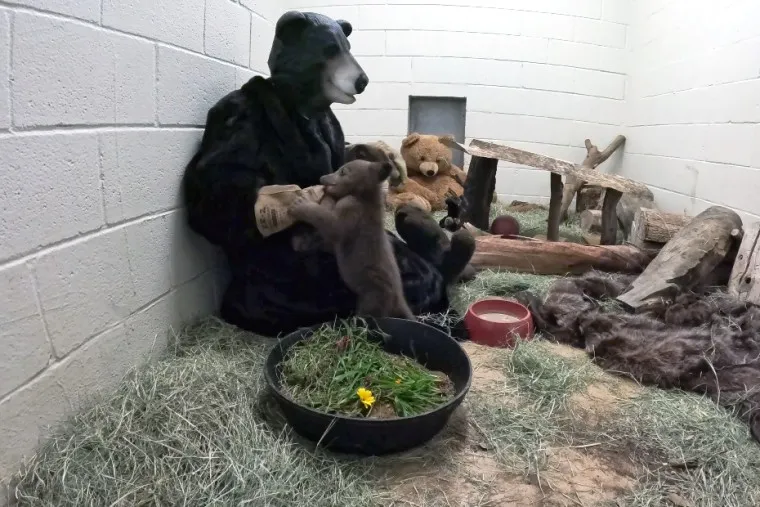
Can Humans in Bear Suits Reshape a Wild Cub’s Destiny?
In a heartwarming yet unconventional twist on wildlife conservation, staff at a California wildlife center are donning bear costumes to raise an orphaned black bear cub, raising questions about how far humans will go to protect endangered species and preserve wild instincts.
The story began when campers in Los Padres National Forest discovered a tiny, starving black bear cub on April 12, weighing just three pounds and alone without his mother. Wildlife officials with the California Department of Fish and Wildlife attempted to reunite him with his mother, but after two days, it became clear she wasn’t returning. The cub was quickly transferred to the San Diego Humane Society’s Ramona Wildlife Center, marking the youngest bear the organization has ever cared for. This event highlights the growing challenges of human-wildlife conflicts in developing areas, where habitat loss often leaves young animals vulnerable.

Under the dedicated care of the center’s team, led by wildlife operations manager Autumn Welch, the cub has made a remarkable recovery. Initially debilitated and dehydrated, he has now quadrupled in size to over 12 pounds after more than a month of round-the-clock attention. Welch explained in a statement, 'He was extremely fragile when he arrived, but now he’s active, eating well, and gaining weight steadily.' To prevent the cub from imprinting on humans—a risk that could lead to dangerous interactions in the wild—staff are employing creative strategies. They wear bear costumes, use plush toys, and even mimic maternal behaviors during enrichment sessions, ensuring the cub sees them as fellow bears rather than providers of food and safety.
This approach underscores a deeper issue in wildlife rehabilitation: the delicate balance between human intervention and preserving natural instincts. Bears are intelligent and food-motivated, Welch noted, and as human development encroaches on their habitats, conflicts arise when animals like this cub become too accustomed to people. By avoiding direct human bonding, the team aims to prepare him for release, potentially pairing him with another orphaned cub to enhance his social development. It’s a rare case, with officials reporting only four such young bears entering rehab in California over the past five years, emphasizing the resource-intensive nature of these efforts, funded entirely through donations.

Comparisons with past rehabilitations show that this method could be a game-changer. For instance, similar techniques have helped other species avoid human dependency, potentially reducing future wildlife-human clashes. Welch added that the cub won’t be released until next spring or summer, when he reaches 130-150 pounds, equipped with a GPS collar for tracking. This level of commitment not only saves individual lives but also contributes to broader environmental goals, like maintaining healthy bear populations amid climate pressures and habitat fragmentation.
In the end, this cub’s journey reflects the extraordinary lengths humans go to for conservation, blending innovation with empathy. As we witness these efforts, it prompts us to consider: How can we better coexist with wildlife in an ever-changing world? Share your thoughts in the comments below—do you think these creative methods will ensure a safer future for wild animals, or is there more we can do?